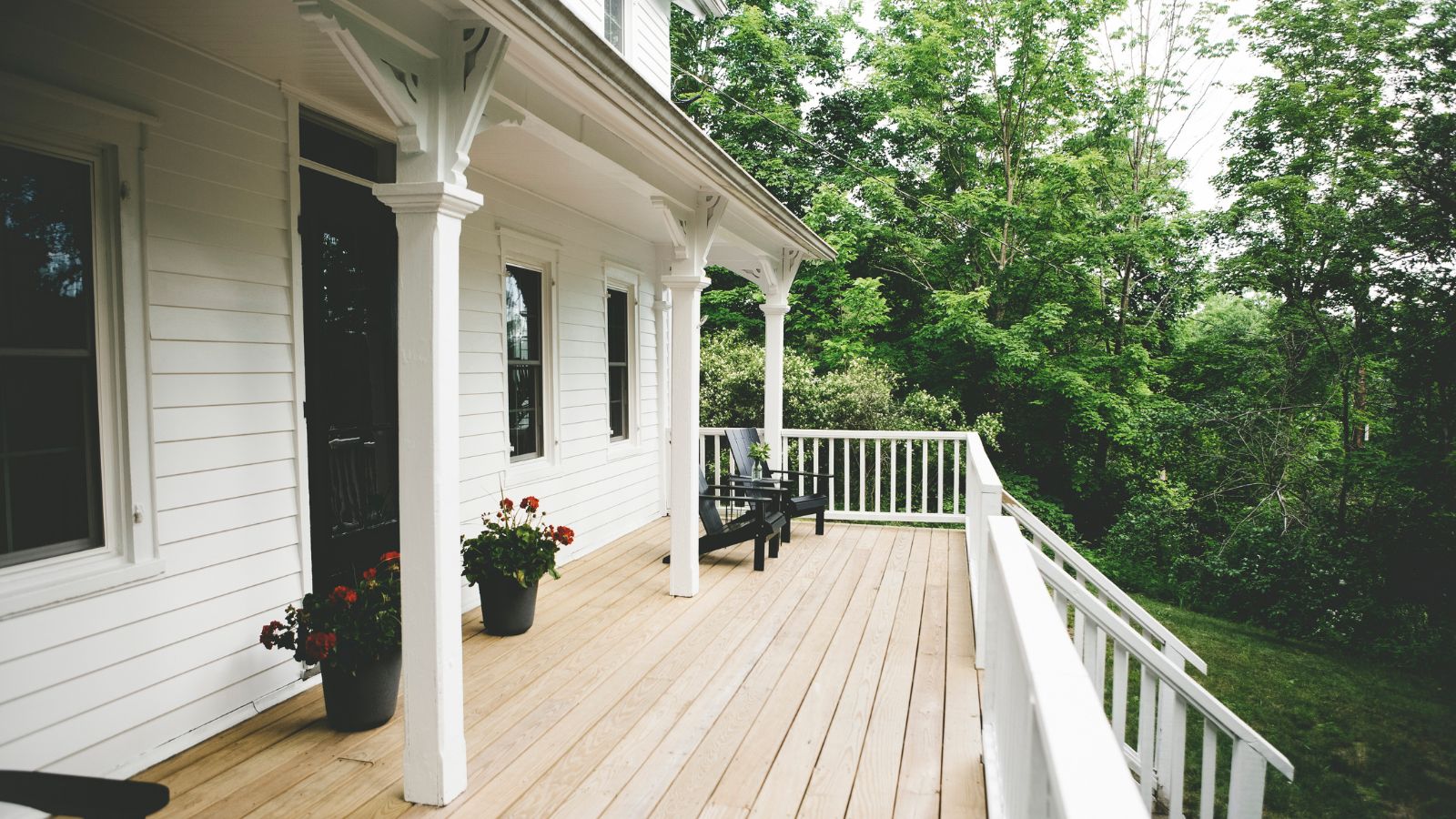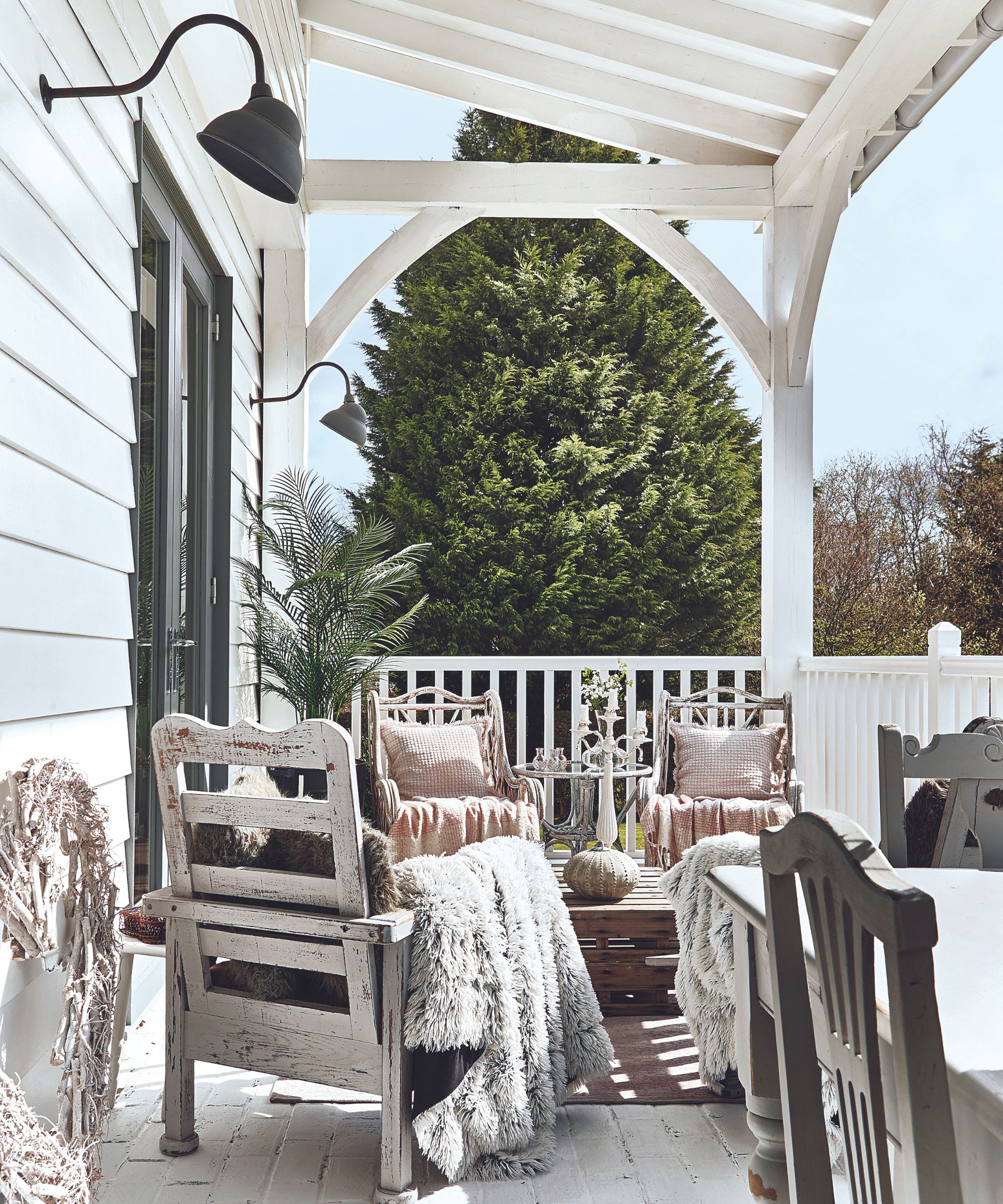How to clean pollen off a porch – 4 methods professionals recommend
These four tips will successfully remove pollen off a porch to reduce allergy symptoms this spring and summer


Pollen is a nightmare for many of us as spring rolls around and our allergies make an appearance yet again. When the velvety yellow dust covers our porches and window frames, however, it becomes more than a nuisance.
The trouble with such fine dust is its ability to cling to everything, and even squeeze through screen doors, so the key is to remove the pollen completely when cleaning a front porch – not just move it around.
These expert cleaning tips for allergy sufferers are perfect for removing pollen from your porch to restore one area of your outdoor space ready for days sitting in the sun.
How to clean pollen off a porch
Even if you have created a low-allergen garden, pollen will blow in from all directions, making it difficult to prevent completely. As a result, knowing how to keep on top of it is essential, especially considering we can't just pop an air purifier outside as we would in our homes.

1. Use a garden hose or pressure washer
While you should never overuse a pressure washer, or use high pressure when cleaning a porch to prevent damaging the flooring, it is one of the best cleaning tips for quickly removing swathes of pollen from your porch quickly, says Ahmad Jamal, cleaning expert at CleanersAdvisor.
When wet, pollen forms clumps, preventing it from blowing up into the air and aggravating your airways, or settling elsewhere, making pressure washing an effective technique.
‘Start by spraying the porch surface thoroughly with water to loosen the pollen. Then, use a stiff-bristled brush or a broom to scrub the surface gently, paying extra attention to areas where the pollen is concentrated,’ Ahmad explains. ‘Finally, rinse the porch surface thoroughly with water to remove all the pollen residue.’
Design expertise in your inbox – from inspiring decorating ideas and beautiful celebrity homes to practical gardening advice and shopping round-ups.

Ahmad is a self-proclaimed 'clean-freak', with years of experience tackling tough cleaning projects and advising others on how to deal with the worst of messes.
2. Consider a pollen remover solution
If you do not have a pressure washer or hose, then you can create a pollen-removing solution from ingredients you likely already have in your home, says Becky Decker, gardens expert at GardeningHood.
‘One popular option is a mixture of warm water and dish soap, but you can also clean with vinegar mixed in equal parts with water, or opt for a commercial cleaning product such as Scotts eco-friendly outdoor cleaner from Amazon,’ she begins.
‘Mix your solution in a bucket, following the instructions on the cleaning product if you're using one before using a scrub brush to apply your cleaning solution to the surface of your porch.
‘Scrub thoroughly, paying extra attention to areas where pollen has built up. Allow the solution to sit for a few minutes, then rinse it off with a bucket of clean water. Make sure to rinse all of the cleaning solutions off of your porch, as any leftover residue can attract more pollen,’ she warns.
Scotts Eco-Friendly Outdoor Cleaner | $11.99 at Amazon
This eco-friendly outdoor cleaner is perfect for removing stubborn pollen and stains from your porch without causing any harm to wildlife or plants in the area.
3. Vacuum pollen up with a HVAC vacuum
Another option for removing pollen is to use a good outdoor vacuum cleaner with an HVAC filter to collect the pollen without scrubbing, suggests Will Cotter, cleaning expert and owner of HappyCleans, Oklahoma. If you have the right tools, this is a great option as wetting pollen can sometimes hide it as it loses its color when damp and remains stuck to the porch flooring.
When using this method, the pollen may be disturbed up into the air as you move around. As a result, it is a good idea to wear a mask such as an N95 mask, at Amazon to catch pollen. If it’s not available, wear multiple layers of cloth masks, Will advises.
4. Avoid using a dry mop or broom
When trying to remove pollen, using a dry brush or mop is a bad idea, cautions Stefan Bucur, founder of Rhythm of the Home, a home services blog. ‘While you would instinctively want to wipe down the excess pollen first using something like a dry mop, this can make the pollen spores fly around and stick onto other items on your porch,’ he explains. Instead, a suction tool, cleaner, or water is your best friend.

Stefan is the founder and owner of the home improvement blog, Rhythm of the Home. He has over six years of experience in home improvement, interior design, cleaning, and organizing.
Why cleaning pollen off a porch is important

Cleaning pollen off of your porch is not just the easiest way to make your front porch look expensive, but it has benefits for your health too, experts say.
‘First and foremost, pollen can trigger allergies and respiratory issues in sensitive individuals. When pollen accumulates on a porch, it becomes airborne easily and can be inhaled by anyone in the vicinity, leading to symptoms such as sneezing, coughing, congestion, and itchy eyes,’ says Ahmad Jamal, cleaning expert.
‘Even if it does not affect you, it could well affect your guests. Regularly cleaning pollen off a porch can help reduce allergen exposure and create a safer and more comfortable outdoor space for those with pollen allergies.
‘Additionally, pollen can also leave unsightly stains and discoloration on porch surfaces, which can detract from the appearance of the outdoor space and contributes to making a house look cheap. Regular cleaning can help maintain the aesthetic appeal of the porch and prevent long-term damage to the surface due to pollen accumulation.’

Removing pollen from entry points like porches is also important to prevent it from being tracked into the house, adds Karina Toner, cleaning expert at Spekless Cleaning. ‘Pollen can easily attach to shoes and clothing, and once inside your home,’ she points out, ‘it can trigger allergies and make your indoor air quality worse. Cleaning your porch properly and regularly is key to allergy-proofing your home.’
Finally, dry pollen can be slippery underfoot, highlights Stefan Bucur, home care expert. This can cause slipping hazards for yourself, your guests, or even just the mailman. Cleaning the pollen up is important to preventing dangerous hazards and injury.
FAQs
When should I clean pollen off my porch?
You can clean pollen off of your porch as often as you need to to help limit your allergy symptoms however experts recommend that you can clean it once monthly and then complete a final big clean in September as the plants begin to quieten down for the fall.
How do you clean pollen off a porch screen?
If your porch door has a yellow hue it is likely covered in pollen. To resolve this, make a simple cleaning solution of ¼ cup of all-purpose cleaner and half a gallon of warm water. Dip a clean cloth in the solution and wipe the screen door down on both sides, rinsing the pollen off of the cloth every so often. To finish, wipe the door down with fresh water and allow it to dry.
Cleaning pollen from a porch may be a tricky task, especially when it can easily become covered again, but if you have bad hay fever, little-and-often cleaning can help you to enjoy your outdoor space over the warmer months, rather than try to weather it out indoors. While these expert tips will not prevent pollen, they are the best way to remove the spores quickly and efficiently.

Chiana has been at Homes & Gardens for two years and is our resident 'queen' of non-toxic living. She spends most of her time producing content for the Solved section of the website, helping readers get the most out of their homes through clever decluttering, cleaning, and tidying tips. She was named one of Fixr's top home improvement journalists in 2024.
